| S 50
- E Series
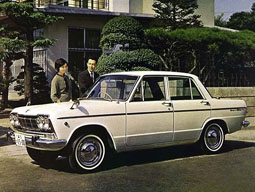 The
Prince Skyline S50-E came out in 1963 and was built till
1968 in sedan (S50) and wagon (W50) form. It featured
the new G1 engine, a 1484ccm OHV 4-cylinder, producing
70hp and in comparison to its predecessor had a more
boxy shape. The S50 introduced the four round tail
lights, a Skyline feature that was kept for many
generations until the
R34 series. It had large round brake lights and
smaller round turn-signals beside them. The
Prince Skyline S50-E came out in 1963 and was built till
1968 in sedan (S50) and wagon (W50) form. It featured
the new G1 engine, a 1484ccm OHV 4-cylinder, producing
70hp and in comparison to its predecessor had a more
boxy shape. The S50 introduced the four round tail
lights, a Skyline feature that was kept for many
generations until the
R34 series. It had large round brake lights and
smaller round turn-signals beside them.
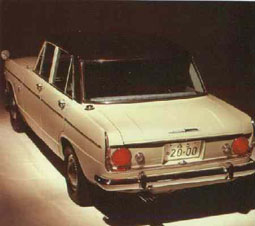 The
car came with two transmissions, a 3-speed column change
gearbox and a more sportive 4-speed floor change
gearbox. Latter version featured bucket seats to support
its more sportive character, while the column shift
version only had a single bench in front. In 1967, the
S50 series was replaced by the S57 series, which came
with the new G15 engine, a 1483ccm OHC 4-cylinder with
88hp. It was the most powerful 1500cc engine in Japan. The
car came with two transmissions, a 3-speed column change
gearbox and a more sportive 4-speed floor change
gearbox. Latter version featured bucket seats to support
its more sportive character, while the column shift
version only had a single bench in front. In 1967, the
S50 series was replaced by the S57 series, which came
with the new G15 engine, a 1483ccm OHC 4-cylinder with
88hp. It was the most powerful 1500cc engine in Japan.
Skyline 2000GT
(S 54 Series)
Birth of a legend
In 1964 Prince started an attempt
to go into racing. For this purpose the S50ís wheel base
was extended by cutting the car off in front of the fire
wall and adding an extra 8 inches of panel work to make
a 6 cylinder engine fit in. Consequently, the G7 engine,
a 1988ccm OHC inline-6 from the upper class S40 Gloria
model, was installed to the car. In the beginning only a
small number of this car were built to homologate it for
GT-class racing, but since it proved very popular,
Prince decided to put it into full production. The
resulting car was called the S54 series or the Skyline
2000GT and came in two versions.
The GT-A
used an unchanged version of the G7 engine with only a
single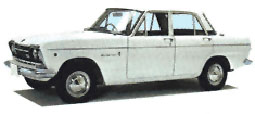 carburetor and 105hp. The GT-B on the other hand got a
5-speed close ratio gearbox, full instrumentation, a
limited slip differential, power brakes, a 99 liter fuel
tank and a high compression version of the G7 with
triple 40DCOE-18 Weber carburetors and 125hp. Both
featured disc brakes with twin piston calipers up front
and alloy finned drum-brakes at the rear. Later models
even had flow through ventilation with small eye ball
vents added to the dashboard.
carburetor and 105hp. The GT-B on the other hand got a
5-speed close ratio gearbox, full instrumentation, a
limited slip differential, power brakes, a 99 liter fuel
tank and a high compression version of the G7 with
triple 40DCOE-18 Weber carburetors and 125hp. Both
featured disc brakes with twin piston calipers up front
and alloy finned drum-brakes at the rear. Later models
even had flow through ventilation with small eye ball
vents added to the dashboard.
Of both, the
GT-B was finally the
one to be used for racing. It finished 2nd in its first
race, the 2nd GP of Japan in 1964 and almost beat the
victorious Porsche 904GTS, which was a pure race car.
This was an incredible achievement considering that the
Skyline was a 4-door sedan. The S54 series was continued
until 1968 and with its several race victories laid the
foundation for the Skyline legend.
 |
 |
|
 |
3rd
Generation (1968 - 72) |
 |
|
 |
 |
 |

|
|
 |
 |
|
The 1500 series
 The
1500 series replaced the S 50 in
July 1968 and was built until
1972. It came in 4-door sedan
and wagon form with the G15
engine from the S57.The same car
was also available as the
1800
with the G18 engine. These cars
were mostly using Prince parts
and were the last Skylines to be
released with the Prince badge,
with all following Skylines to
be renamed Nissan Skyline. The
1500 series replaced the S 50 in
July 1968 and was built until
1972. It came in 4-door sedan
and wagon form with the G15
engine from the S57.The same car
was also available as the
1800
with the G18 engine. These cars
were mostly using Prince parts
and were the last Skylines to be
released with the Prince badge,
with all following Skylines to
be renamed Nissan Skyline.
The Skyline 2000GT (GC10 series)
Just like
all other derivatives of the C10
series, the
GC10 (G standing for GT) was
basically planned by Prince,
although it was later badged
Nissan Skyline 2000GT. It was
introduced in 1968 (2 months
after the 1500) and first came
in 4-door sedan (GC10) and
5-door wagon versions and from
1970 on also with two doors
(KGC10). The car was almost the
same as the preceding S54 GT-A
model, featuring a 6-cylinder
engine instead of the previously
common 4-cylinder. The Skyline
2000GT got the L20 engine, a
1998ccm OHC inline-6 with 105hp.
The
Skyline 2000 GT-R
(PGC-10 series)
1968 had
seen the introduction of a basic
Skyline (the 1500 series) and a
model comparable to the previous
GT-A (the GC10 series). But
people were still eagerly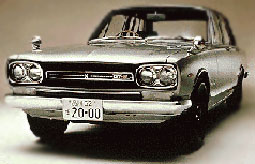 awaiting a replacement for the
GT-B. Almost a year passed after
the intro-duction of the new
model range, until finally in
February 1969 the new GT-R sedan
came along.
awaiting a replacement for the
GT-B. Almost a year passed after
the intro-duction of the new
model range, until finally in
February 1969 the new GT-R sedan
came along.
This car was about to
write history!
The
Skyline 2000GT-R was powered by
the S20 engine, a 1998ccm DOHC
inline-6, producing 160hp -
equally strong as a Porsche 911
of that time. This engine was
basically the same as the GR8 of
Nissanís R380 racecar, which won
the 3rd GP of Japan in 1966
against a Porsche Carrera 6.
Since it
was intended for racing, the
PGC10 (P stood for Prince) was
very lightweight inside, without
a heater or radio, but from the
outside almost looked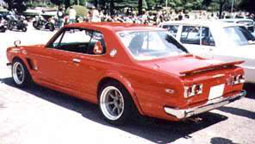 like any other 4-door sedan.
After over two years, the
coupe-version of the GT-R
(KPGC-10) was introduced in
March 1971. A shorter wheelbase
and less weight made for a
better maneuver-ability in
comparison to the 4-door version
and further enhanced this car's
capability on the circuit. The
Skyline 2000GT-R lived up to the
racing pedigree of its
predecessors and the sedan
scored 33 victories in those
one-and-a-half years it raced,
which was raised to 50 victories
by the KPGC-10, until its
production was stopped in 1972.
like any other 4-door sedan.
After over two years, the
coupe-version of the GT-R
(KPGC-10) was introduced in
March 1971. A shorter wheelbase
and less weight made for a
better maneuver-ability in
comparison to the 4-door version
and further enhanced this car's
capability on the circuit. The
Skyline 2000GT-R lived up to the
racing pedigree of its
predecessors and the sedan
scored 33 victories in those
one-and-a-half years it raced,
which was raised to 50 victories
by the KPGC-10, until its
production was stopped in 1972.
The Skyline had become a
Legend after all. |
 |
|
 |
 |
 |
|
|
 |
 |
 |
|
 |
4th
Generation (1972 - 77) |
 |
|
 |

|
|
The C110
series was built from 1972 until
1977 and came in four versions.
Firstly,
there were two basic versions
now, the
1600GT and the
1800GT,
both using derivatives of the
G15 engine, the G16 (1.6l) and
the G18 (1.8l) respectively. The
third model was the
2000GT-X,
which could be compared to the
C10 2000GT. It was powered by an
improved version of the L20
engine with an output of 130hp
instead of the earlier 109hp.
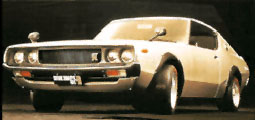 The
most powerful of the quartet,
though, was the
2000 GT-R,
using an unchanged version of
the S20 engine with still 160hp.
Similar to its prede-cessor from
1969, the GT-R
was avail-able as a coupe
(KPGC110) and a 4-door sedan
(PGC110). The
most powerful of the quartet,
though, was the
2000 GT-R,
using an unchanged version of
the S20 engine with still 160hp.
Similar to its prede-cessor from
1969, the GT-R
was avail-able as a coupe
(KPGC110) and a 4-door sedan
(PGC110).
With only
197 unit produced, this was to
be the last car to wear the GT-R
badge for more than a decade,
and the only one ever not to be
used in racing at all. |
|
 |
 |
|
 |
5th
Generation (1977 - 81) |
 |
|
 |

|
|
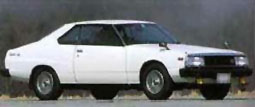 The
C211 series was released in
August 1977 and, just like the
C110 series, came in four
versions. First of all, due to
the fuel crisis and emissions
regulations, the GT-R
was missing and instead the
Skyline
2000GT-ES (KGC211) marked
the top-of-the-line now. The
C211 series was released in
August 1977 and, just like the
C110 series, came in four
versions. First of all, due to
the fuel crisis and emissions
regulations, the GT-R
was missing and instead the
Skyline
2000GT-ES (KGC211) marked
the top-of-the-line now.
The latter
came out in April 1980 and
featured a new turbo-version of
the L20, called the L20ET, with
140hp. This engine might have
been less powerful than the
GT-Rs, but in contrast to the
S20, obeyed to emissions
regulations and marked a new
milestone in Skyline history:
For the first time a turbo
engine powered a Skyline.
The basic
versions were called
1600TI
and 1800TI
now and featured L16 and L18
engines respectively, instead of
the preceding "G" engines. The
old
2000GT-X lost the X (and
was now called the 2000GT), but
kept an unchanged L20 engine,
which still pumped out 130hp. |
|
|
| |
|
 |
|
 |

|
|
 |
|
 |
|
With the R30
series, Nissan
started to
change the
nomenclature of
the Skyline. For
the rest of the
century, all
Skyline
generations
would be called
R3X.
The new
line-up was
released in
August 1981 and
came in 5
different
models. Its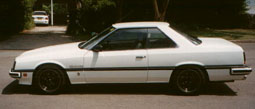 design was
dramatically
different in
comparison to
its
predecessors,
since this new
Skyline looked
very boxy in
shape and much
more like an
ordinary sedan
than earlier
Skylines. Even
though, it
marked a step
back to the
sporty roots of
the Skyline.
design was
dramatically
different in
comparison to
its
predecessors,
since this new
Skyline looked
very boxy in
shape and much
more like an
ordinary sedan
than earlier
Skylines. Even
though, it
marked a step
back to the
sporty roots of
the Skyline.
Earlier
versions had
constantly been
gaining weight,
which
consequently
slowed them down
and made them
less agile. This
was changed with
this new
generation,
although it was
not until 1982
that a really
sporty Skyline
hit the road
again.
For the basic
versions, the
L16 engine was
dropped, so only
the
1800TI
remained, which
now used the Z18
4-cylinder
engine with
105hp. The
stronger
2000GT
and
2800GT
both came with
inline-6 engines
instead.
The R30 Skyline
RS
After Nissan
had dropped the
GT-R, there had
been no DOHC
engine in the
Skyline line-up
anymore. Since
the oil-crisis,
the turbo had
emerged, but a
DOHC was still
missing. The
introduction of
the Skyline RS
was to change
this condition
in October 1981.
It came in sedan
and coupe form
with the new
FJ20E engine, a
2.0l
four-cylinder
pumping out
150hp, which was
directly aimed
at racing.
In 1983 this
engineís
performance was
improved by a
turbo, so the
resulting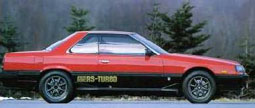 FJ20ET (T
standing for
turbo) now
produced 190hp,
which was later
boosted to an
astonishing
205hp by the
addition of an
intercooler.
FJ20ET (T
standing for
turbo) now
produced 190hp,
which was later
boosted to an
astonishing
205hp by the
addition of an
intercooler.
This Skyline
became known as
the RS-X or the
Turbo C. The
result was not
only the until
then ďstrongest
Skyline everĒ,
but also a very
successful track
car.
The
Skyline was back
on track! |
 |
|
|
 |
 |
 |
|
 |
7th Generation
(1985 - 91) |
 |
|
 |
 |
 |

|
|
 |
|
 |
|
Since the R30
was very
successful,
Nissan did not
change much of
the outward
appearance of
its successor,
the R31 series.
At its debut,
the car was
introduced only
in all forms of
4-door versions.
Due to the
popularity of
luxury cars,
this Skyline was
aimed at the
luxury
department and
seemed to have
lost its focus
on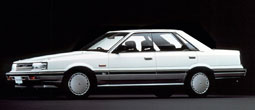 sportiness. The
base model was
the
1800I,
now using the CA
18, a 1.8l DOHC
4-cylinder with
100hp.
sportiness. The
base model was
the
1800I,
now using the CA
18, a 1.8l DOHC
4-cylinder with
100hp.
But the R31
also saw the
introduction of
a new engine
family, the RB20
engines which
worked in the
Passage GT.
Especially the
RB20DET, a 2.0l
DOHC inline-6
turbo with 180hp
at 6400rpm,
stood out here
as a very potent
machine. It was
the first in a
great family of
engines that the
later GT-R's
RB26DETT and
other Skyline
engines up to
the R34 series
also belonged
to.
The GTS Coupes
People had to
wait for a
two-door until
the GTS hit the
showrooms in May
1986. This coupe
got the RB20DET
engine from the
Passage GT. It
was renamed GTS-X
in 1988 and got
an improved
RB20DET version
with now 190hp.
More
important about
this car,
though, was the
appearance of
the
HICAS (High
Capacity Active
Steering)
all-wheel-steer
system for the
first time in
Skyline history.
This system is
still used on
todayís top
Skyline versions
and improves the handling of the
car immensely.
handling of the
car immensely.
The most
famous of the
GTS models was
the GTS-R,
though, which
was developed
especially for
racing. The
180hp in the
standard model
may not have
been bad, but
were still short
of the 205hp
featured in the
R30 RS-X. This
is why Nissan
introduced the
R31 Skyline GTS-R
in 1987 with a
RB20DET engine
tuned to 210hp
thanks to a
different
turbocharger and
different
exhaust
manifolds. The
engine tuning
was supported by
an improved
suspension and
tuning on many
other parts of
the car, to give
the GTS-R a
sportier overall
character. With
only 200 built
examples, this
is still a
highly desired
car today.
|
|
 |
 |
 |
 |
|
The 1989 R32 was the resurrection of old Skyline virtues, in that each of its many versions were very sporty and balanced in handling. The car came in sedan,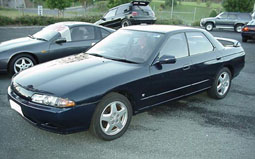 coupe and finally also in GT-R form and for the first time in history, was available with rear-wheel-drive and all-wheel-drive. coupe and finally also in GT-R form and for the first time in history, was available with rear-wheel-drive and all-wheel-drive.
The old engine line-up was mostly dropped, so all versions - sedans and coupes - at least got the RB20DE engine, a normally aspirated 2.0l inline-6 with 155hp. Stronger models like the GTS-t came with the RB20DET engine, already known from the R31 GTS-R, but with an increased output of 212hp. Later versions got the normally aspirated RB25DE engine, a 2.5l DOHC inline-6 with 180hp. |
 |
|

|
 |
 |
|
|
 |
 |
|

|
 |
 |
| The R32 Skyline GT-R 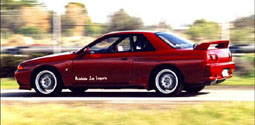 Over a decade after the last GT-R had been dropped, a new Skyline GT-R finally saw the light of day in 1989. Of course, expectations for the new top-performer were high due to the heritage it could look back upon. But this new version was more than worth the GT-R badge in any way. Over a decade after the last GT-R had been dropped, a new Skyline GT-R finally saw the light of day in 1989. Of course, expectations for the new top-performer were high due to the heritage it could look back upon. But this new version was more than worth the GT-R badge in any way.
At that time it may have seemed impossible for any car to resemble the PGC10ís success on and off the track - that was, until the new R32 GT-R came along, which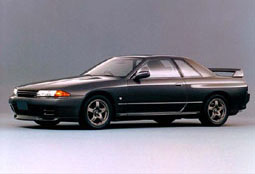 soon earned the nickname Godzilla. The Skyline GT-R was available only in coupe form and featured high-tech in perfection, high-tech that in this case was used to support the driving experience, rather than hinder it. soon earned the nickname Godzilla. The Skyline GT-R was available only in coupe form and featured high-tech in perfection, high-tech that in this case was used to support the driving experience, rather than hinder it.
It came with ATTESA-ETS (Advanced Total Traction Engineering System for All - Electronic Torque Split), an electronically controlled all-wheel-drive system that usually delivers the power to the rear-wheels, but can send up to 50% of the torque to the front wheels. Thus even drifts are possible with this car, which is usually very difficult with AWD. The handling was further enhanced by Super-HICAS, an improved system of the R31 GTS-Xís all-wheel-steering, to make this car one of the best, if not THE best handling car in the world.
The GT-R did not only have excellent handling characteristics, but also featured one of the best production engines of all times, the RB26DETT, a 2.6l DOHC inline-6 twin turbo with 280hp. The RB26DETT is a pure racing engine, derived directly from Group A racing, which was despecíed to fit the maximum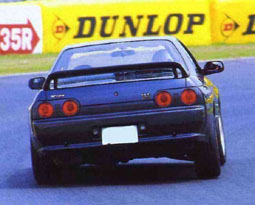 280hp allowed by Japanese regulations. Tuned (newer) versions of this engine, however, have been seen to reach up to 1300hp, so make sure to check out the Tuning section of this site, because tuning is what the Skyline really is all about. Still, the standard version makes the 0-60mph sprint in 4.8 seconds, putting it on a par with a Ferrari 355. 280hp allowed by Japanese regulations. Tuned (newer) versions of this engine, however, have been seen to reach up to 1300hp, so make sure to check out the Tuning section of this site, because tuning is what the Skyline really is all about. Still, the standard version makes the 0-60mph sprint in 4.8 seconds, putting it on a par with a Ferrari 355.
But the GT-R was not only a great street rocket. It was basically designed to fit Japanese Group A racing standards. And racing is where Godzilla really shone. It won so many races (i.e. it won every single race - 29 altogether) in Group A that this class was abolished because nobody wanted to compete against Nissan's flagship anymore. |
 |
|

|
 |
 |
|
|
 |
|
|

|
 |
 |
|
 |
9th Generation (1993 - 99) |
 |
|
 |
 |
 |
 |
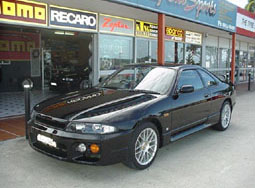 The R33 series was very similar to its predecessor, the R32 series. The GT-R was continued, as was the optional all-wheel-drive layout of the sedans and coupes. The car was still very sporty, although it had grown a little in size and weight and had thus become less agile. The weight disadvantage was compensated in the engine department though, by the new normally aspirated RB25, a 2.5l inline-6 with 190hp for the GTS-4 and GTS25 versions, and the far more powerful RB25DET, a 2.5l inline-6 turbo with an output of 255hp, which worked in the GTS25t. The R33 series was very similar to its predecessor, the R32 series. The GT-R was continued, as was the optional all-wheel-drive layout of the sedans and coupes. The car was still very sporty, although it had grown a little in size and weight and had thus become less agile. The weight disadvantage was compensated in the engine department though, by the new normally aspirated RB25, a 2.5l inline-6 with 190hp for the GTS-4 and GTS25 versions, and the far more powerful RB25DET, a 2.5l inline-6 turbo with an output of 255hp, which worked in the GTS25t.
|
 |
|

|
 |
 |
|
|
 |
| The R33 Skyline GT-R A heavy burden lay upon the R33's back when it was introduced in 1995. Itís predecessor had been very successful (almost unbeatable) and anybody hardly 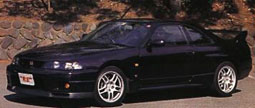 thought the new GT-R could possibly improve on the R32ís performance. Surprisingly, the R33 GT-R was better than the old version in almost any way, although it too had gained some weight. thought the new GT-R could possibly improve on the R32ís performance. Surprisingly, the R33 GT-R was better than the old version in almost any way, although it too had gained some weight.
It kept the RB26DETT engine with an unchanged 280hp, but had a broader torque band which made the engine more flexible. Also standard were improved versions of ATTESA-ETS and Super-HICAS. |
 |
|

|
 |
 |
|
|
 |
 |
|

|
 |
 |
| NISMO 400R and GT-R LM NISMO stands for Nissan Motorsports and is the (you guessed it!) Motorsports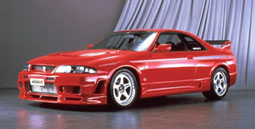 division of Nissan which was responsible for the former Group A racing cars, as well as todayís JGTC (All Japan Grand Touring Car Championship) racing cars. Since engine power for production cars is restricted to 280hp in Japan, having a car built by a tuning division is the only way to get over such a regulation. And this is exactly what Nissan did with the 400R in February 1996, a car that was produced in a very limited number of only 99 pieces. division of Nissan which was responsible for the former Group A racing cars, as well as todayís JGTC (All Japan Grand Touring Car Championship) racing cars. Since engine power for production cars is restricted to 280hp in Japan, having a car built by a tuning division is the only way to get over such a regulation. And this is exactly what Nissan did with the 400R in February 1996, a car that was produced in a very limited number of only 99 pieces.
Nissan had been racing the Skyline in the GT1 category of the 24-hours endurance race of Le Mans in 1995 and 1996, so the GT-R LM and the 400R were intended as road-going versions of these race cars. Both got derivatives of the RB26DETT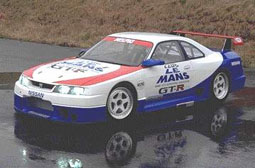 engine, the GT-R LM with 305hp and the 400R with 400hp. Unfortunately only one GT-R LM was built to homologate the car for racing, which is confined to a museum today. engine, the GT-R LM with 305hp and the 400R with 400hp. Unfortunately only one GT-R LM was built to homologate the car for racing, which is confined to a museum today.
The 400R on the other hand, got an enlarged RB26DETT engine with 2.8l of displacement, the RBX-GT2, a twin-turbo with an astonishing 400hp at 6.800rpm. The engine was not the only similarity with the GT-R though, since both cars were based upon the R33 GT-R V-spec (Victory Specification). But where the GT-R LM only got RWD (like the race-cars), the 400R got further improved GT-R technology, like ATTESA-ETS etc.
 Naturally, both carís inner potency was resembled in their design as well. Each one of them featured bigger wheels, wider spoilers and wheel-arches and lower suspension, to give them a look even more dramatic than the already not too inconspicuous standard GT-R. Naturally, both carís inner potency was resembled in their design as well. Each one of them featured bigger wheels, wider spoilers and wheel-arches and lower suspension, to give them a look even more dramatic than the already not too inconspicuous standard GT-R.
|
 |
|

|
 |
 |
|
|
 |
| Autech GT-R 4-door Autech is a subsidiary of Nissan specialized in tuning cars. The Autech GT-R was a four-door version of the R33 GT-R, which was introduced as a limited edition for the 40th birthday of the Nissan Skyline. The Autech version got all of the GT-Rís standard technology, as well as the most vital parts of its interior like bucket seats etc. So it really was a GT-R in terms of performance - just a lot more practical.
NISMO also brought up a tuned version of the Autech GT-R, which featured the spoilers of the NISMO 400R and a 380hp engine. It is not difficult to imagine that this car was THE attraction on its debut at the Tokyo Motor Show. |
|
|
|
|
|
|
|
|
|